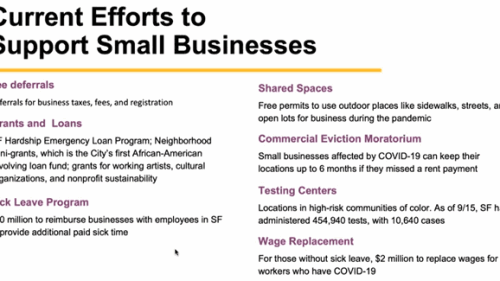The health and economic effects of COVID-19 on the multifamily industry, in terms of exacerbating existing problems related to the nation’s affordable housing shortage, were discussed by housing experts and advocates convened April 7 for a ULI webinar on the impacts of the coronavirus outbreak on lower-income renters.
“Confronting COVID-19: Considerations for Multifamily and Affordable Housing,” hosted jointly by ULI’s Terwilliger Center for Housing and the Institute’s Responsible Property Investment Council, was the third in a series of ULI webinars exploring how the virus is affecting the real estate industry, along with the industry’s response.
The webinar is free to access on ULI Knowledge Finder.
Megan Sandel, codirector of the GROW clinic at the Boston Medical Center, co–lead principal investigator at Children’s HealthWatch, and associate professor of pediatrics at Boston University, discussed the relationship between housing and physical and mental health. The coronavirus pandemic has spotlighted how housing can serve much like a “vaccine” that helps foster greater social equity and promote overall well-being, Sandel said.
Four factors that define place—quality, stability, affordability, and location—have been elevated in importance by the outbreak, demonstrating that “you cannot separate your health from where you live,” she said.
Social factors—both positive and negative—affect health outcomes, Sandel said, noting that the pandemic has underscored the interrelation of social factors such as access to food and stable housing as health determinants. “Social factors should not be thought of as individual factors, but thought of collectively,” she said, pointing to housing quality as a predictor of children’s development and behavior in school.
In addition, factors that contribute to housing quality and health quality, such as ventilation, plumbing, air quality, and water quality, have become even more significant with people sheltering in place during the outbreak, Sandel noted. “Our homes are not necessarily designed to be occupied 24 hours a day [in terms of infrastructure stresses], so we need to be thoughtful about designing housing in the future that will be more resilient,” she said.
Sandel noted that while the homeless population is the most visible evidence of the nation’s affordable housing shortage, a less visible segment, the “housing insecure” population—associated with multiple moves, living in overcrowded conditions, and falling behind on rent payments—is also attributable to unaffordable housing. Research prepared by Children’s HealthWatch shows that factors associated with housing insecurity, including falling behind on rent, can be as detrimental to children’s health as having no housing, she said.
“In the COVID era, millions more families will be behind on rent, and they could suffer from the same adverse health outcomes that we typically associate with homelessness,” said Sandel.
She noted that the virus pandemic has undermined the factorsthat comprise well-being, which include having social connections, feelingsafe, feeling stable, feeling in control of one’s environment, and havingmeaningful access to resources. Housing stability, a powerful contributor towell-being, must become more broadly accessible to increase social equity inurban areas, Sandel said. “Housing acts as a vaccine to provide equity, and itis only through equity that we all get the same fair shot [at well-being].”
Doug Bibby, president of the National Multifamily Housing Council (NMHC), discussed provisions in the recently enacted Coronavirus Aid, Relief, and Economic Security (CARES) Act related to the multifamily industry. The act provides benefits to renters suffering economic hardships due to the coronavirus, including cash payments to qualifying households and eviction moratoriums, and it provides apartment owners with some mortgage forbearance.
Though there was broad understanding during legislation deliberations of the dire need to keep renters from losing their housing, Bibby said, less well understood was the harmful multiplier effect that cascades throughout the apartment industry when renters are unable to pay rent over a sustained period.
According to Bibby, about 45 percent of U.S. rental units are owned by companies, including small businesses and pension funds representing moderate-income workers such as teachers and other service employees. Because the livelihood of smaller apartment owners and the retirement savings of pension fund participants depend on timely rental payments, both groups could be adversely affected by a large drop in rent payments, he said.
As a result, when eviction moratoriums were being added to the CARES Act, the apartment industry urged the inclusion of mortgage forbearance for apartment owners.
“Without provisions for forbearance, apartment owners couldnot sustain months of lower payments and would almost certainly would have tocut staff and services,” adding a new layer of difficulty in keeping buildingsclean and sanitized for occupant safety, he said. While CARES did includeforbearance, the timing does not align with the eviction moratoriums and needsto be adjusted in the next phase of federal support, Bibby added.
For the immediate term, NMHC has recommended to its members that they contact each resident in their apartment communities and work with those negatively affected by the coronavirus on alternative pricing strategies. “Our message is, work with residents any way you can,” Bibby said.
Strategies now in place include a rent relief fund started by one member, a rent reduction program started by another, and several flexible payment plans. NMHC plans to use data from a new survey on rent collections reflecting the impact of the virus to help inform subsequent economic relief/stimulus legislation, he said.
In addition to a modification of the multifamily mortgageforbearance and eviction moratorium provisions, NMHC will advocate for anemergency housing assistance fund for renter households; expansion of the SmallBusiness Administration’s Paycheck Protection Program to include multifamilybusinesses; enactment of the Multifamily Depreciation Parity Act; and infrastructureinvestment packages that promote affordable housing construction and rehabilitation.
Diane Yentel, president and chief executive officer of the NationalLow-Income Housing Coalition (NLIHC), described how the nation’s homelessnesscrisis and the coronavirus crisis are exacerbating each other, with thehomeless population being at extreme risk for contracting and spreading thevirus, and with the financial ruin attributable to the virus adding to the alreadyrising numbers of homeless people and those at risk of being homeless.
Before the outbreak, Yentel said, about 8 million people inthe United States were not yet homeless but were considered severely cost burdened(paying 50 percent or more of their incomes for housing), often doubling up andtripling up with other households. “With such limited income, you have no cushionto absorb a financial shock, and the coronavirus is definitely a financialshock,” she said. Given the soaring job losses among the lowest-wage workers causedby virus-related business closures, NLIHC is predicting an increase of 1.5million severely cost-burdened renters.
“Because we [as a nation] have not addressed housing shortagesand the reality of homelessness for so many years, we now face these chillingscenarios in which people who are sleeping in homeless encampments and have noaccess to water or soap are facing a pandemic. We have to consider what happenswhen we have millions of people who, on a good day, are on the cusp of losingtheir homes [are] in the middle of a pandemic when our collective healthdepends on our ability to stay home,” Yentel said. “What the coronavirus hasshown in a profound way is that housing is health care. We will not contain thepandemic until every one of us is able to isolate.”
She pointed out that deaths caused by the virus are disproportionately high among lower-income people of color, particularly African Americans. “The underlying health conditions that put people at risk of getting sick or dying of the virus, such as heart ailments, diabetes, and asthma, are the same conditions that come from living in poverty,” Yentel said.
As a result, it is important that federal economic relief efforts for renters affected by the virus include provisions to protect and house people who are homeless, prevent more people from becoming homeless, and preserve the limited affordable housing that exists in the United States, she said.
NLIHC advocated for the CARES Act to include significantfunding for homeless outreach workers and shelter providers through an EmergencySolutions Grants program that will help secure housing for homeless peopleduring the pandemic and reduce crowding in shelters. In addition, NLIHCadvocated for additional Community Development Block Grant funding thatcommunities can use for emergency rental assistance, as well as additional fundingfor subsidized housing programs to help offset the lost income from rentalpayments.
Yentel noted that the NLIHC is seeking the inclusion of anational eviction moratorium in the subsequent federal aid package to replacethe numerous eviction moratoriums now in place at the federal, state, and locallevels; and it is seeking a major emergency rental assistance program to help low-incomerenters pay back rent owed, as well as smaller landlords who rely on rentalincome to maintain and operate affordable units.
“We don’t want to end this crisis by losing some of theimportant affordable housing infrastructure in this country,” she said. Gettingand keeping people off the streets and protected from the virus is critical toprotecting “families, cities, the whole country,” Yentel said. “We all have astake in getting this right.”
The coronavirus webinar series is being provided by ULI’s Building Healthy Places Initiative, created in 2013 to leverage the power of ULI’s global networks to shape projects and places in ways that improve the health of people and communities. The goal of the series is to help members understand the role they can play in helping slow the spread of the disease, help them navigate the long- and short-term impacts of the crisis, and help them understand how they can play a role in minimizing adverse impacts on vulnerable people.
For more information related to COVID-19 and real estate,visit PublicHealth and Real Estate: Resources on COVID-19 at uli.org.
TRISH RIGGS, former senior vice president of communications at ULI, is now a freelance writer based in Falls Church, Virginia.



